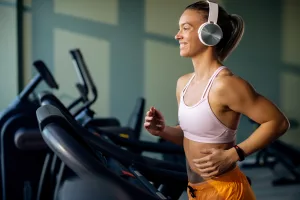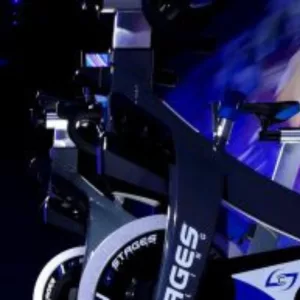Key takeaways
- What is RPE for indoor workouts?
- How to judge your rate of perceived exertion
- How RPE relates to Zones
- Using RPE to get the most out of your indoor cardio workout
Try your first Cardiofit indoor ride/run/row workout FREE
What is RPE for indoor cycling?
RPE stands for Rate of Perceived Exertion and it’s a subjective measure of how hard you’re working your body on a scale from 1-10 where 1 is very easy and 10 is as hard as you can go.
Basically RPE is how hard it feels during your workout out of 10.
While it may seem a little quaint to use a subjective measure of exertion in an age of data and technology, it is surprisingly accurate and will be a huge benefit if you’re just getting started with indoor cycling.
RPE is often used in guided cardio workouts to help you measure how hard to push yourself at various points during the session.
For example, during a warmup, the instructor might ask you to aim for an RPE of 2-3/10 as you get ready for the main set in the indoor workout.
During a hill climb or sprint, the instructor will likely ask you to aim for an RPE of 8-9/10 for a short burst of say, 30 seconds as part of a HIIT workout.
For longer work periods, for example a 2-3 minute hill climb, the instructor might aim for an RPE around 6-7/10. This will enable this segment to be achievable while still being challenging over the longer period.

Here’s an approximation of how RPE might feel from 1-10 on a stationary bike:
- Just turning over the pedals
- Really easy
- Easy
- A pace you could ride all day
- Moderate
- Slightly hard
- Hard
- Really hard
- Crazy hard
- All out
See below for more on how to determine your indoor training RPE.
Try your first Cardiofit indoor cycle workout FREE
How to judge your Rate of Perceived Exertion
When you’re first getting started with guided audio workouts, it may be hard to know just how hard your 9-10/10 RPE actually feels.
Here’s an overview of how each level of RPE feels to help you judge how you’re going –
| RPE | How it should feel |
|---|---|
| 1-2 | Super easy – just turning over the legs, breathing through your nose. |
| 2-4 | Easy pace, feels nice and light, you should be able to hold this level all day. |
| 4-5 | Fairly easy pace, you’re not panting and can still talk easily. Probably breathing through your mouth now. |
| 6-7 | Sustainable for max 1 hr of consistent riding. Fairly hard, and only chatting now in short phrases. Breathing becomes harder. |
| 8 | This is a hard pace where you can only say a few words at a time and you’ll only be able to sustain for perhaps 2-3 minutes maximum. |
| 9 | Very hard, not sustainable for long (30-90s) and not possible to talk. |
| 10 | As hard as you can go. Think of this like the hardest, fastest sprint you’ve ever done. You’ll only be able to keep this pace for a very short amount of time and talking will be limited to grunts, groans and screams (!) |
TIP: Print and keep a copy of the above table next to your bike, treadmill or ergo if you need a reference to Power Zones.
Notice that one way to tell how hard you’re exerting yourself is whether you can speak in full sentences. If you can, you’re working at 5 or less RPE.
As you climb higher on the scale, talking (and breathing!) becomes harder and more laboured so by 7-8/10 you shouldn’t be able to hold a conversation if you tried.
You’ll improve your ability to judge RPE over time, so don’t stress if you don’t get it right straight away and your first few workouts are a little too hard or too easy.

Image by Drazen Zigic on Freepik
Why use RPE for indoor workouts?
RPE is used when running, cycling or rowing on indoor equipment that isn’t equipped with sensors and power meters.
If you’re spinning at a gym, your bike probably only shows you the speed of your pedals (cadence) and perhaps your power output and has one knob that adjusts the resistance (how hard it is to pedal).
Similarly with treadmills and ergos (rowing machines).
But how do you know how much to adjust the resistance to ensure you get fitter?
It’s important to judge and monitor the intensity of your workout or you will likely make little progress in your training, so that’s where RPE comes in.
If you’re using an audio workout app like cardiofit, the instructor will tell you what RPE to hold during each section of the workout.
You need to turn the resistance knob on your equipment so that you are in the right RPE range for each section of the workout. See above table for how to judge your rate of perceived exertion.
Once you’ve found the right resistance setting for the RPE the instructor has requested, hold it there through the interval. Don’t back it off! It will be hard at times, but that’s the point of following a guided audio cycle workout. You’ll get fitter.
TIP: As you’re working through a training interval during a workout, take note of the position of the resistance knob on your bike (or the level number on the treadmill or ergo), or how many turns (eg. quarter turn, half turn, full turn) you made so that you can match that setting on the next interval requiring a similar RPE

Conclusion
A key piece to RPE is to be honest with yourself about how you’re feeling.
It’s also important to note that RPE is a personal metric: One rider may have an RPE of 5 when riding at 260 watts, while another may experience an RPE of 9, and everyone will experience an RPE of 10 as horrible!
If you are working at an RPE of 6.5 instead of 5 or 7, only you can tell. Honesty counts.
As I said earlier, you’ll get better at judging your RPE over time but also keep in mind that it will also change depending on how tired you are during a workout. The same sprint done at the start and end of a workout will have a different RPE.
And, like following any recommended training programs, it’s only useful if you hold the RPE requested for the set interval duration, but do that for long enough and complete enough audio training sessions and you’ll see your fitness improve in no time.
Let me know if you have any questions about RPE in the comments below.